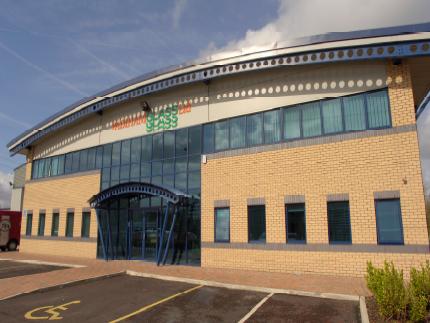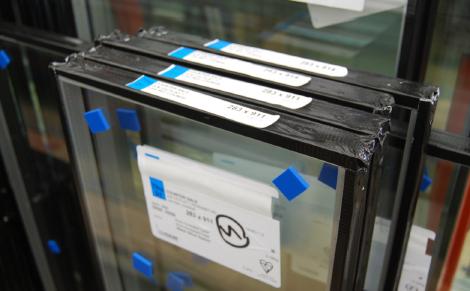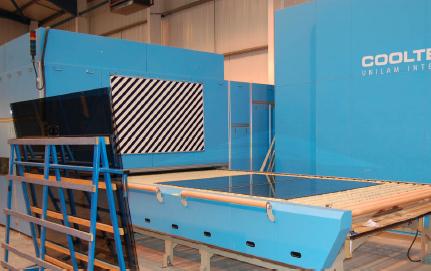“…all of Clear Thinking’s help has meant that changing the most fundamental part of our business (the software) was a painless experience.”
Clear Thinking have recently implemented their ‘sub batching’ glass optimisation software at Padiham Glass. “We thought that by doing large batches of daily production, we had reached the practical limit of waste saving,” says Jeremy Kemp, Production Director at the Padiham Glass factory in Lancashire, “But Malcolm Searle and his team from Clear Thinking Software showed us how to reduce our wastage figures still further, with their sophisticated racking and batching techniques. This has also had the additional side effect of smoothing production flow through the factory and reducing the headcount in the despatch department.”
Padiham Glass’ offices (above)
“We are currently manufacturing about 900 -1500 units per day in one shift, mixed between large high performance for the commercial market and standard 4mm/4mm for the trade and domestic/social housing market. We used to make one large batch of float units, then one large batch of toughened units, then several smaller batches with more varied products in. This is our third computer system since we started the business, and at last we’ve found the ‘cream of the crop’. Our older MSDOS systems optimised reasonably well, but they were written for simpler times, before the advent of K glass or softcoat. Now that we’ve graduated onto Clear Thinking’s sophisticated optimiser, it has given us substantial savings.
“With the new revolutionary ‘sub batching’ system from Clear Thinking, all the glass is cut in a continuous batch, and toughened glass and float glass can be mixed together on one stock sheet for most products. This means that we get better yield, as the yield on toughened glass was slightly lower than with float glass, due to the slightly larger average size of the pieces. Naturally, they recommended that we keep our remakes and customer service batch, as well as the main batch.”
“The glass is now presented to the Superspacer® sealing line in the sequence which both minimises changes of spacer type and also suits the despatch department, and so it’s very easy to stack units on stillages immediately it comes off the line. This has benefits in terms of quality (less scratches), manpower (less men are needed to find and collate the glass), space (each stillage is located in turn near the end of the line- then moved away as it’s filled) and delivery on time targets (if a unit is missing or broken – the despatch loader knows immediately and action can be taken straightaway).”
“The extra benefit of the ‘bullet’ labelling system means that the despatch team know from the label how many units they have coming off together (eg. 1 of 8), and each job is designated by it’s own coloured symbol, so that loading is quick and intuitive. The bullet part of the label is stuck onto the side of the unit (see below), which means that all units of a stillage can be identified by looking at the edge of the unit, rather than tipping some units forward to look at the labels on the face of the glass that may be hidden behind other units. This also means that barcoding can be done without disturbing or scratching the units, and so improves quality and reduces additional labour needed to manhandle glass.
“Because the software can predict the number of units (possibly from several orders) that will be coming down the sealing line, this information can be presented to the despatch department well in advance, so that they can get the correct stillages ready for loading. This means they get the right size stillage for the customer’s requirements.”
“The glass cutters are now instructed to cut glass in the most efficient sequence that the software tells them to, which has additional benefits. Previously the cutters were not aware of the bigger picture and the possible impact of leaving out a unit (say, of 6mm) from the middle of an order. Often this would be a large unit and would, therefore, be best put on the stillage first – making this last would often cause a lot of re-stacking in the despatch department, with its associated problems. The Clear Thinking system overcomes this without any negative impact on wastage, and in fact increases the previous yield in this situation by ‘pre-cutting’ any other 6mm glass that will be required later.”
“At first, this all sounded ‘too good to be true,” comments Wes Clarkson, Padiham’s Sales Director, “But once Malcolm had explained in detail how the system worked and had offered to show us the system working in other factories, it became a very simple business decision of how soon could we implement the system and start getting the savings. Looked at another way, every week we delayed the implementation was a week we were wasting more money. But without the sophistication of the software, we would never have been able to make these savings manually or with our existing production methods.”
“Now that we’ve had the system for 12 months, we’re happy that it has paid for itself,” continues Wes, “Not just in hard measurable terms like material wastage, but also in factory flow and more difficult to value areas, like reducing quality issues, speeding up despatch, ensuring vehicles go out on time.”
Clear Thinking collaborated closely with Padiham’s IT department. Ben Sorrell says, “We worked very closely with Clear Thinking and once we all understood what needed to be done, it was a relatively straightforward exercise to implement their software, as it’s very user friendly and we were allocated a senior software engineer to oversee our project, and he made himself available on a weekly basis. Malcolm Searle also visited us numerous times during the implementation and ‘go-live’ stages of the project and all of this help has meant that changing the most fundamental part of our business (the software) was a painless experience.”
“Now that we have made progress in the production department, we are now working towards a situation where a large percentage of our glass orders come in electronically by EDI (Electronic Data Interchange), where the glass is specified as part of a window frame by our customers, and all the specifications and sizes are imported into the software. This means everything is much quicker and more accurate than manual entry and that no-one is re-typing information needlessly.”
“Additionally, Clear Thinking have measured our furnace throughput and calculated how much glass we need to cut in advance to keep the furnace running at peak performance with no delays, so that the furnace is never idle.”
Padiham’s Cooltemper furnace (above)
The next stage of software development will be centred around the changes needed by the company’s recent acquisition of a brand new Forel Commercial manufacturing line, enabling the automatic gas pressing and sealing line to suit sizes up to 2500 x 5000 (mm).
Malcolm Searle of Clear Thinking concludes, “It’s been gratifying that our long term investment in learning the theoretical side of lean manufacturing and other manufacturing techniques and putting a huge amount of R&D into our software over the last few years, is now paying off for more forward thinking glass companies. We like to think that we have contributed significantly to Padiham’s production processes and most importantly their bottom line. Which, after all, is why we produce innovative production software.”
http://www.padihamglass.co.uk/
Article first appeared in Glass Times – January 2010



